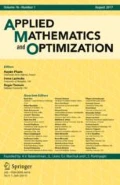Abstract
Sufficient optimality conditions for infinite-dimensional optimization problems are derived in a setting that is applicable to optimal control with endpoint constraints and with equality and inequality constraints on the controls. These conditions involve controllability of the system dynamics, independence of the gradients of active control constraints, and a relatively weak coercivity assumption for the integral cost functional. Under these hypotheses, we show that the solution to an optimal control problem is Lipschitz stable relative to problem perturbations. As an application of this stability result, we establish convergence results for the sequential quadratic programming algorithm and for penalty and multiplier approximations applied to optimal control problems.
Similar content being viewed by others
References
Alt W (1989) Stability of solutions for a class of nonlinear cone constrained optimization problems, Part 1: Basic theory. Numer Funct Anal Optim 10:1053–1064
Alt W (1990) Stability of solutions to control constrained nonlinear optimal control problems. Appl Math Optim 21:53–68
Alt W (1991) Parametric optimization with applications to optimal control and sequential quadratic programming. Bayreuth Math Sehr 35:1–37
Dontchev AL, Hager WW (1993) Lipschitzian stability in nonlinear control and optimization. SIAM J Control Optim 31:569–603
Dontchev AL, Hager WW (1994) Implicit functions, Lipschitz maps, and stability in optimization. Math Oper Res 19:753–768
Dunn JC, Tian T (1992) Variants of the Kuhn-Tucker sufficient conditions in cones of nonnegative functions. SIAM J Control Optim 30:1361–1384
Hager WW (1985) Approximations to the multiplier method. SIAM J Numer Anal 22:16–46
Hager WW (1990) Multiplier methods for nonlinear optimal control. SIAM J Numer Anal 27:1061–1080
Hager WW, Ianculescu G (1984) Dual approximations in optimal control. SIAM J Control Optim 22:423–465
Ito K, Kunisch K (1992) Sensitivity analysis of solutions to optimization problems in Hilbert spaces with applications to optimal control and estimation. J Differential Equations 99:1–40
Malanowski K (1988) On stability of solutions to constrained optimal control problems for systems with control appearing linearly. Arch Automat Telemech 33:483–497
Malanowski K (1992) Second-order conditions and constraint qualifications in stability and sensitivity analysis of solutions to optimizations problems in Hubert spaces. Appl Math Optim 25:51–79
Malanowski K (preprint) Two norm approach in stability and sensitivity analysis of optimization and optimal control problems
Maurer H (1981) First- and second-order sufficient optimality conditions in mathematical programming and optimal control. Math Programming Stud 14:163–177
Maurer H, Zowe J (1979) First- and second-order necessary and sufficient optimality conditions for infinite-dimensional programming problems. Math Programming 16:98–110
Orrell K, Zeidan V (1988) Another Jacobi sufficient criterion for optimal control with smooth constraints. J Optim Theory Appl 58:283–300
Reid WT (1972) Riccati Differential Equations. Academic Press, New York
Robinson SM (1976) Stability theory for systems of inequalities, Part II: Differentiable nonlinear systems. SIAM J Numer Anal 13:497–513
Robinson SM (1980) Strongly regular generalized equations. Math Oper Res 5:43–62
Rudin W (1966) Real and Complex Analysis. McGraw-Hill, New York
Ursescu C (1975) Multifunctions with closed convex graph. Czechoslovak Math J 25:438–441
Yang B (1991) Numerical Methods for Nonlinear Optimal Control Problems with Equality Control Constraints. PhD dissertation, Department of Mathematics, Colorado State University, Fort Collins, CO
Zeidan V (1984) Extended Jacobi sufficiency criterion for optimal control. SIAM J Control Optim 22:294–301
Zeidan V (1984) First- and second-order sufficient conditions for optimal control and the calculus of variations. Appl Math Optim 11:209–226
Zeidan V (1993) Sufficient conditions for variational problems with variable endpoints: coupled points. Appl Math Optim 27:191–209
Author information
Authors and Affiliations
Additional information
Communicated by I. Lasiecka
This research was supported by the U.S. Army Research Office under Contract. Number DAAL03-89-G-0082, by the National Science Foundation under Grant Number DMS 9404431, and by Air Force Office of Scientific Research under Grant Number AFOSR-88-0059. A. L. Dontchev is on leave from the Institute of Mathematics, Bulgarian Academy of Sciences, Sofia, Bulgaria.
Rights and permissions
About this article
Cite this article
Dontchev, A.L., Hager, W.W., Poore, A.B. et al. Optimality, stability, and convergence in nonlinear control. Appl Math Optim 31, 297–326 (1995). https://doi.org/10.1007/BF01215994
Accepted:
Issue Date:
DOI: https://doi.org/10.1007/BF01215994
Key words
- Sufficient optimality conditions
- Stability
- Sensitivity
- Sequential quadratic programming
- Penalty/multiplier methods



